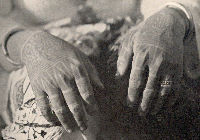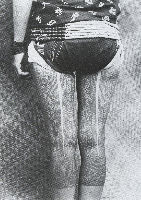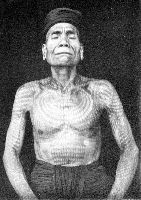 1) Dayak, ca. 1927. Credit: H.F.
Tillema. Dayak woman's hand tattoos. The black spikes that run from the knuckles to the mid-digits are called
song irang (shoots of bamboo), the lines that run horizontally behind the knuckles are called ikor (lines), and the design on the wrists is ?
It is possible that this is an anthropomorph of some kind and may represent silong lejau (tiger's faces). 1) Dayak, ca. 1927. Credit: H.F.
Tillema. Dayak woman's hand tattoos. The black spikes that run from the knuckles to the mid-digits are called
song irang (shoots of bamboo), the lines that run horizontally behind the knuckles are called ikor (lines), and the design on the wrists is ?
It is possible that this is an anthropomorph of some kind and may represent silong lejau (tiger's faces).
 2)
Dayak, ca. 1927. Credit: H.F. Tillema. Dayak woman's thigh tattoo. This woman was of high rank as evidenced by the number of rings around the calves. The motif running up the thighs is called silong lejau (tiger's faces). At the terminus of these bands you can barely make out a different
pattern just above the horizontal lines on the calf. This is called nang klinge (important design) and is a degraded anthropomorph. What is unusual is that this
design is usually found on the kneecaps of both men and women and this tattoo was the one reserved for the last portion of the body tattoo. The
curlicues below the horizontal ikor around the calves are called tushun tuva (the tuba root
motif). What is great about this photo is that the unmarked portions of her thigh are visible. These were important because if a woman decorated these areas (known as tedak danau - lake tattoo), her legs would become mortified. 2)
Dayak, ca. 1927. Credit: H.F. Tillema. Dayak woman's thigh tattoo. This woman was of high rank as evidenced by the number of rings around the calves. The motif running up the thighs is called silong lejau (tiger's faces). At the terminus of these bands you can barely make out a different
pattern just above the horizontal lines on the calf. This is called nang klinge (important design) and is a degraded anthropomorph. What is unusual is that this
design is usually found on the kneecaps of both men and women and this tattoo was the one reserved for the last portion of the body tattoo. The
curlicues below the horizontal ikor around the calves are called tushun tuva (the tuba root
motif). What is great about this photo is that the unmarked portions of her thigh are visible. These were important because if a woman decorated these areas (known as tedak danau - lake tattoo), her legs would become mortified.
 3)
Dayak, ca. 1927, 3)
Dayak, ca. 1927,
Credit H.F. Tillema.
Foot tattoo of lower caste Dayak woman with abstract dragon motif on
shin. (Women of higher caste have concentric circles tattooed
further up the thigh)
Top of page |
 4)
Dayak, ca. 1927. Credit: H.F. Tillema. Thigh and calf tattoos of a Dayak woman. The ikor
(lines) that run below the knee and calf show high status. The snake-like motif is actually a dog derivative called tuang buvong asu (dog without tail). This design is also engraved on Dayak sword
blades. The motif at the bottom of these verticle bands, the coil that looks like an abstract letter A, is a tuba root
(tushun tuva) pattern representing an anthropomorph/spirit of some kind. Sometimes
the dog motif is replaced with a similar design element that represents the hornbill, a bird sacred to most peoples of Borneo - strong sexual symbolism here. (NOTE: Oftentimes, women became ill as a result of being tattooed with infected needles. Many subsequently died.) Tattooing on the back of the thighs usually took the better portion of several weeks. 4)
Dayak, ca. 1927. Credit: H.F. Tillema. Thigh and calf tattoos of a Dayak woman. The ikor
(lines) that run below the knee and calf show high status. The snake-like motif is actually a dog derivative called tuang buvong asu (dog without tail). This design is also engraved on Dayak sword
blades. The motif at the bottom of these verticle bands, the coil that looks like an abstract letter A, is a tuba root
(tushun tuva) pattern representing an anthropomorph/spirit of some kind. Sometimes
the dog motif is replaced with a similar design element that represents the hornbill, a bird sacred to most peoples of Borneo - strong sexual symbolism here. (NOTE: Oftentimes, women became ill as a result of being tattooed with infected needles. Many subsequently died.) Tattooing on the back of the thighs usually took the better portion of several weeks.
 5)
Dayak, ca. 1896. Credit: Dr. A.W. Nieuwenhuis. 5)
Dayak, ca. 1896. Credit: Dr. A.W. Nieuwenhuis.
The central tattoo design on his chest represents the trunk of the
garing tree; adjoining it above are two great designs depicting the
wings of a hornbill. What is significant about this aesthetic is that
the hornbill symbolizes speed, strength, and cunning while the garing motif
represents invulnerability, since this tree is believed to never die.
The tattooing that appears down the arms and over the shoulders
represents the leaves of the areca palm. In a sense, then, this Dayak
man is covered with a visual canopy of the creatures and plants that
live within his jungle domain. Furthermore, and when combined together,
they act as an indelible form of camouflage acting upon the malevolent
forces encountered in the jungle - headhunters and evil spirits.
Research by Lars Krutak
|

 1) Dayak, ca. 1927. Credit: H.F.
Tillema. Dayak woman's hand tattoos. The black spikes that run from the knuckles to the mid-digits are called
song irang (shoots of bamboo), the lines that run horizontally behind the knuckles are called ikor (lines), and the design on the wrists is ?
It is possible that this is an anthropomorph of some kind and may represent silong lejau (tiger's faces).
1) Dayak, ca. 1927. Credit: H.F.
Tillema. Dayak woman's hand tattoos. The black spikes that run from the knuckles to the mid-digits are called
song irang (shoots of bamboo), the lines that run horizontally behind the knuckles are called ikor (lines), and the design on the wrists is ?
It is possible that this is an anthropomorph of some kind and may represent silong lejau (tiger's faces).
 4)
Dayak, ca. 1927. Credit: H.F. Tillema. Thigh and calf tattoos of a Dayak woman. The ikor
(lines) that run below the knee and calf show high status. The snake-like motif is actually a dog derivative called tuang buvong asu (dog without tail). This design is also engraved on Dayak sword
blades. The motif at the bottom of these verticle bands, the coil that looks like an abstract letter A, is a tuba root
(tushun tuva) pattern representing an anthropomorph/spirit of some kind. Sometimes
the dog motif is replaced with a similar design element that represents the hornbill, a bird sacred to most peoples of Borneo - strong sexual symbolism here. (NOTE: Oftentimes, women became ill as a result of being tattooed with infected needles. Many subsequently died.) Tattooing on the back of the thighs usually took the better portion of several weeks.
4)
Dayak, ca. 1927. Credit: H.F. Tillema. Thigh and calf tattoos of a Dayak woman. The ikor
(lines) that run below the knee and calf show high status. The snake-like motif is actually a dog derivative called tuang buvong asu (dog without tail). This design is also engraved on Dayak sword
blades. The motif at the bottom of these verticle bands, the coil that looks like an abstract letter A, is a tuba root
(tushun tuva) pattern representing an anthropomorph/spirit of some kind. Sometimes
the dog motif is replaced with a similar design element that represents the hornbill, a bird sacred to most peoples of Borneo - strong sexual symbolism here. (NOTE: Oftentimes, women became ill as a result of being tattooed with infected needles. Many subsequently died.) Tattooing on the back of the thighs usually took the better portion of several weeks.


